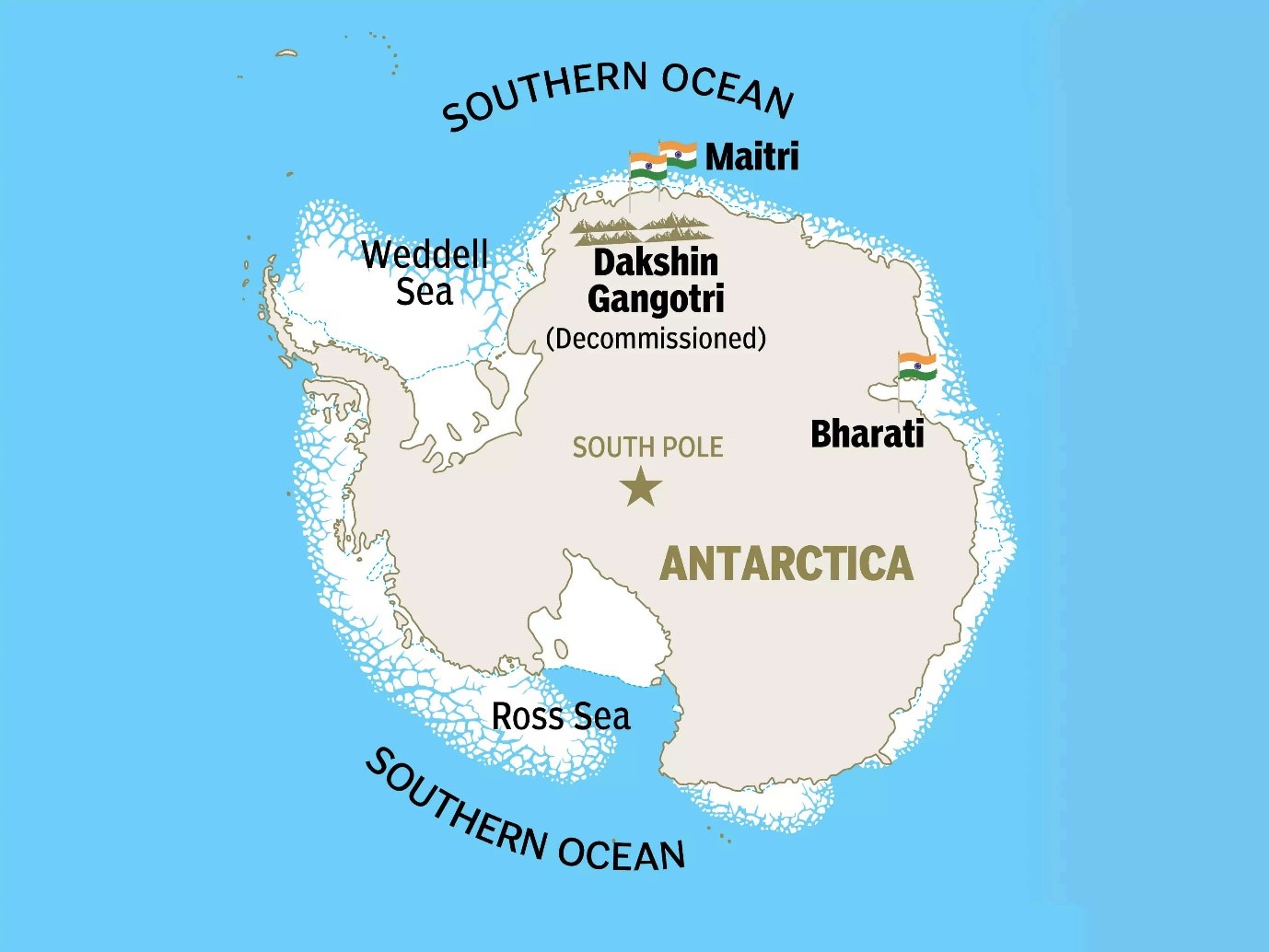- Courses
- GS Full Course 1 Year
- GS Full Course 2 Year
- GS Full Course 3 Year
- GS Full Course Till Selection
- MEP (Mains Enrichment Programme) Data, Facts
- Essay Target – 150+ Marks
- Online Program
- GS Recorded Course
- NCERT- First Ladder
- Polity
- Geography
- Economy
- Ancient, Medieval and Art & Culture AMAC
- Modern India, Post Independence & World History
- Environment
- Governance
- Science & Technology
- International Relations and Internal Security
- Disaster Management
- Ethics
- Current Affairs
- Indian Society and Social Issue
- CSAT
- 5 LAYERED ARJUNA Mentorship
- Public Administration Optional
- ABOUT US
- OUR TOPPERS
- TEST SERIES
- FREE STUDY MATERIAL
- VIDEOS
- CONTACT US
India’s New Post Office in Antarctica
India’s New Post Office in Antarctica
20-04-2024
- In a recent development in April 2024, the Department of Posts inaugurated a second post office branch at the Bharati research station in Antarctica, marking the first expansion in nearly forty years.
- As part of this initiative, letters designated for Antarctica will now bear a unique experimental PIN code, MH-1718, tailored for the new branch.
Historical Background
- In 1984, shortly after India’s first foray to Antarctica, its first post office on the icy continent was set up at Dakshi Gangotri.
- It was the nation’s first scientific base in Antarctica.
- Within the first year, as many as 10,000 letters and mail had been posted and ‘cancelled’ at the historic post office.
- Dakshin Gangotri submerged in ice in 1988-89 and was subsequently decommissioned. On January 26, 1990, a post office branch was set up at India’s Maitri research station on Antarctica.
- Since then, for more than 35 years, letters and postcards in blank envelopes are sent — mostly by philatelists, collectors and hobbyists — to the Maitri post office for ‘cancellation’.
- The impression, ‘Maitri North Goa’, from the Antarctic research base is a famed “collector’s item”.
- Almost four decades later, letters meant for Antarctica will now have a new PIN code, MH-1718, with the Department of Posts opening a second branch of the post office on Bharati research station in Antarctica.
Operational Process of Letters
- Letters meant for the post office in Antarctica are sent to the National Centre for Polar and Ocean Research (NCPOR) in Goa.
- When a scientific expedition to Antarctica departs from NCPOR, a researcher carries the consignment of letters.
- At the research base, the letters are ‘cancelled’, brought back, and returned via post.
- The term ‘cancellation’ refers to the mark placed on a stamp or postal stationery to render it useless for reuse.
Strategic Importance
- The presence of an Indian post office in Antarctica holds strategic significance. While traditionally Indian post offices operate within Indian Territory, the Antarctic post office serves as a symbolic assertion of India’s presence on the continent.
- This initiative underscores India’s dedication to scientific exploration and environmental conservation.
- For researchers stationed in Antarctica for extended periods, being able to send and receive mail from home through a familiar Indian postal service can be a morale booster, helping them stay connected to loved ones.
India At The Antarctic
- India’s Antarctic Programme represents a significant commitment to scientific research, environmental conservation, and international cooperation in Antarctica.
- India’s Antarctic Programme is a scientific research and exploration program under the National Centre for Antarctic and Ocean Research (NCPOR). It started in 1981 when the first Indian expedition to Antarctica was made.
- India has been a Consultative Party to the Antarctic Treaty since 1983. It participates in the decision-making process along with other 28 Consultative Parties to the Antarctic Treaty to date.
- India’s first Antarctic research station, Dakshin Gangotri, was established in 1983. At present, India operates two year-round research stations: Maitri (1989) and Bharati (2012).
- The permanent research stations facilitate Indian Scientific Expeditions to Antarctica, which have been ongoing annually since 1981. In 2022, India enacted the Antarctic Act, reaffirming its commitment to the Antarctic Treaty.
- Dakshin Gangotri (1983-1991): This pioneering research station, established in 1983, marked India’s initial foray into Antarctica. Notably, it was the first time an Indian team wintered over on the continent, a crucial milestone for scientific research. While eventually decommissioned due to being submerged by ice, Dakshin Gangotri’s legacy lives on as a symbol of India’s early Antarctic endeavours.
- Maitri (1989): Commissioned in 1989, Maitri stands as India’s first permanent research station in Antarctica. Located near Schirmacher Oasis, this all-weather station allows researchers to conduct year-round scientific studies in various disciplines, including atmospheric sciences, biology, geology, and glaciology.
- Bharati (2012): India’s most recent research station, Bharati, was inaugurated in 2012. Situated in a region with minimal snowfall, this station facilitates research on upper atmospheric studies, coastal processes, and the impact of climate change.
- Sagar Nidhi: In 2008, India commissioned the Sagar Nidhi, the pride of the National Institute of Ocean Technology (NIOT), for research. An ice-class vessel, it can cut through thin ice of 40 cm depth and is the first Indian vessel to navigate Antarctic waters.

The Indian Antarctic Act, 2022
- The Indian Antarctic Act, 2022 received the assent of the Hon’ble President of India on 6th August 2022 and then notified in the Gazette of India on 8th August 2022.
- The Act aims to provide for national measures for protecting the Antarctic environment and dependent and associated ecosystems and to give effect to the Antarctic Treaty, the Convention on the Conservation of Antarctic Marine Living Resources, the Protocol on Environmental Protection to the Antarctic Treaty and for matters connected therewith or incidental thereto.
- The Bill passed by Lok Sabha on 22nd July 2022 and by Rajya Sabha on 1st August 2022.
- According to the provisions of the Act, the Committee on Antarctic Governance and Environmental Protection (CAG-EP) has been constituted and notified by the Central Government which (but not be limited to) has the following functions:
- to monitor, implement and ensure compliance with the relevant international laws, emission standards and rules for the protection of the Antarctic environment by the Operators or by any other persons engaged in programmes and activities in Antarctica;
- to undertake any advisory, supervisory or enforcement activities in relation to programmes and activities in Antarctica;
- to obtain and review relevant information and reports provided by Parties to the Treaty, the Convention the Protocol and other Parties engaged in programmes and activities in Antarctica.
About National Centre for Polar and Ocean Research (NCPOR)
|



